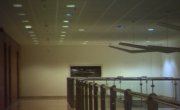Yoav Y. Schechner: Research
Computational Imaging on the Electric Grid

Night beats with alternating current (AC) illumination. By passively sensing this beat, we reveal new scene information which includes: the type of bulbs in the scene, the phases of the electric grid up to city scale, and the light transport matrix. This information yields unmixing of reflections and semi-reflections, nocturnal high dynamic range, and scene rendering with bulbs not observed during acquisition. The latter is facilitated by a database of bulb response functions for a range of sources, which we collected and provide (DELIGHT). To do all this, we introduce a novel coded-exposure high-dynamic-range imaging technique, specifically designed to operate on the grid’s AC lighting. This camera system, which we built and demonstrate, is the ACam.
Publications
- Mark Sheinin, Yoav Y. Schechner and Kiriakos. N. Kutulakos, “Computational imaging on the electric grid,” Proc. IEEE CVPR (2017) Oral, Best Student Paper Award.
- Mark Sheinin, Yoav Y. Schechner and Kiriakos. N. Kutulakos, “Computational imaging on the electric grid: Supplementary material,” Supplemental document in Proc. IEEE CVPR (2017), describing the DELIGHT database and some technical aspects.
Presentations
- A narrated presentation in YouTube, intended for the wider audience.
- Computational Imaging on the Electric Grid, A presentation with embedded videos and graphics, intended for the wider audience (61 Mb, PowerPoint).
- A video is supplemental to the CVPR official publication. (13.9 Mb, mp4).
Data
DELIGHT is a Database of Electric LIGHTs. It contains bulb response functions ahnd chromaticities, as described in our paper. Available for non-commercial use. You can use it if you clearly acknowledge the source by citing "Computational imaging on the electric grid" detailed above, in your work.- The database DELIGHT described in the CVPR'17 paper Computational imaging on the electric grid. (74 Mb)


